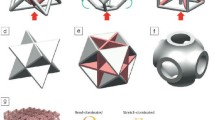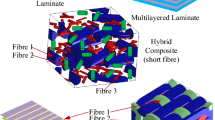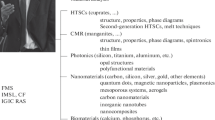Abstract—The scientific foundations for mesostructure formation in composite materials have been developed. These materials are divided into four structural classes, and structure formation in each class possesses some unique features. The conditions for the formation of equilibrium mesostructures and the distinctive features of liquid phase mass transfer upon the interaction of the mesoelements and the matrix have been assessed in thermodynamics studies, and the conditions of mesostructure generation in composite nanomaterials have been substantiated. The distinctive features of mesocomposite material formation have been considered for each of the classes identified. Mesostructure generation in composite materials has been shown to enable a substantial improvement of the properties and performance characteristics of these materials and thus ensure breakthroughs in different fields of technology.









Similar content being viewed by others
REFERENCES
Brookes, K.J.A., World Directory and Handbook of Hardmetals and Hard Materials, East Barnet: International Carbide Data, 1992, 5th ed.
Chaurasia, J., Ayyapan, M., Patel, P., and Rajan, R.A.A., Activated sintering of tungsten heavy alloy, Sci. Sintering, 2017, vol. 49, pp. 445–453.
Flis, A.A., Minakova, R.V., Teodorovich, O.K., Vorona, D.S., and Antoshina, R.I., Tungsten carbide pseudoalloys and their potential applications, Sov. Powder Metall. Met. Ceram., 1980, vol. 19, no. 2, pp. 112–117.
Lesnik, N.D., Minakova, R.V., and Khomenko, E.V., Chromium–copper system: Adhesion characteristics, alloying, and structure of composite materials, Poroshk. Metall., 2001, nos. 7–8, pp. 137–147.
Bondarenko, N.A., Zhukovskii, A.N., and Mechnik, V.A., Osnovy sozdaniya almazosoderzhashchikh kompozitsionnykh materialov dlya porodorazrushayushchikh instrumentov (Creation of Diamond-Containing Composites for Mineral Destroying Tools), Kyiv: Inst. Sverkhtverd. Mater., Nats. Akad. Nauk Ukr., 2008.
Mechnik, V.A., Production of diamond–(Fe–Cu–Ni–Sn) composites with high wear resistance, Powder Metall. Met. Ceram., 2014, vol. 52, nos. 9–10, pp. 577–587.
Bondarenko, V.P., Tribotekhnicheskie kompozity s vysokomodul’nymi napolnitelyami (Tribological Composites with High Modular Fillaers), Kiev: Naukova Dumka, 1987.
Chmielewski, M., Pietrzak, K., Strojny-Nędza, A., Kaszyca, K., Zybała, R., Bazarnik, P., Lewandowska, M., and Nosewicz, S., Microstructure and thermal properties of Cu–SiC composite materials depending on the sintering technique, Sci. Sintering, 2017, vol. 49, pp. 11–22.
Vlasova, M., Bykov, A., Kakazey, M., Aguilar, P.A.M., Melnikov, I., Rosales, I., and Tapia, R.G., Formation and properties of TiB2–Ni composite ceramics, Sci. Sintering, 2016, vol. 48, pp. 137–146.
Deng, X., Patterson, D.R., Chawla, K.K., Koopman, M.C., Fang, Z., Lockwood, G., and Griffo, A., Mechanical properties of a hybrid cemented carbide composite, Int. J. Refract. Met. Hard Mater., 2001, vol. 19, pp. 547–552.
Bondar’, M.P., Korchagin, M.A., and Obodovskii, E.S., High-energy methods of creating a mesocomposite material with inclusions containing nanocrystalline particles, Combust., Explos. Shock Waves (Engl. Transl.), 2010, vol. 46, no. 1, pp. 111–116.
Lisovsky, A.F., Thermodynamics of the formation of mesostructures in composite materials, Fiz. Mezomekh., 2011, vol. 14, no. 4, pp. 11–16.
Lisovsky, A.F., Formation of nonequilibrium dihedral angles in composite materials, J. Int. Powder Metall., 1990, vol. 26, no. 1, pp. 45–49.
Lisovsky, A.F., Some problems on technical use of the phenomenon of metal melts imbibition of sintered composites, Powder Metall. Int., 1989, vol. 21, no. 6, pp. 7–9.
Lisovsky, A.F., The phenomenon of absorption of metal melts by non-porous composite materials: Scientific substantiation and practical application, Sverkhtverd. Mater., 2001, no. 1, pp. 3–10.
Lisovsky, A.F., Thermodynamics of processes of consolidation of an assembly of dispersed particles and deconsolidation of a polycrystalline body, Sci. Sintering, 2002, vol. 34, no. 2, pp. 135–142.
Lisovsky, A.F., Deconsolidation of polycrystalline skeletons in sintered composite materials, Mater. Sci. Forum, 2009, vol. 623, pp. 43–56.
Lisovsky, A.F., Formirovanie struktury kompozitsionnykh materialov pri obrabotke metallicheskimi rasplavami (Formation of Structure of Composite Materials during Processing with Metal Melts), Kyiv: Naukova Dumka, 2008.
Lisovsky, A.F., The migration of metal melts in sintered composite materials, Int. J. Heat Mass Transfer, 1990, vol. 33, no. 8, pp. 1599–1603.
Matveichuk, A.A. and Davidenko, S.A., On the interaction of the cobalt melt with polycrystalline tungsten monocarbide, J. Superhard Mater., 2018, vol. 40, no. 3, pp. 184–188.
Lisovskii, A.F., Thermodynamics of the particle consolidation in a three-phase system, J. Superhard Mater., 2007, vol. 29, no. 4, pp. 224–227.
Lisovskii, A.F., Thermodynamics of sintering composite materials with the liquid phase present, J. Superhard Mater., 2010, vol. 33, no. 3, pp. 166–172.
Lykov, A.V., Teplomassoobmen (Heat and Mass Exchange), Moscow: Energiya, 1972.
Prigogine, I., Introduction to Thermodynamics of Irreversible Processes, New York: Wiley, 1955.
Lisovsky, A.F., Thermodynamics of the formation of mesostrucnure in nanodispersed composite materials, Sci. Sintering, 2009, vol. 41, pp. 293–301.
Lisovsky, A.F., On the application of Laplace pressure in the science of sintering, Sci. Sintering, 2010, vol. 42, pp. 357–362.
Petrov, Yu.I., Klastery i malye chastitsy (Clusters and Microparticles), Moscow: Nauka, 1986.
Vul’f, Yu.V., Izbrannye raboty po kristallofizike i kristallografii (Selected Papers on Crystal Physics and Crystallography), Moscow: Gostekhizdat, 1952.
Kushch, V.I., Lisovsky, A.F., and Shestakov, S.I., Modeling of the mesostructure in sintered hard alloys, Sverkhtverd. Mater., 2003, no. 3, pp. 32–40.
Loshak, M.G., Prochnost’ i dolgovechnost’ tverdykh splavov (Strength and Durability of Sold Alloys), Kiev: Naukova Dumka, 1984.
Fang, Z.Z., Giffo, A., White, B., Lockwood, G., Belnap, D., Hilmas, G., and Bitler, J., Fracture resistant super hard materials and hardmetals composite with functionally designed microstructure, Int. J. Refract. Met. Hard Mater., 2001, vol. 19, pp. 453–459.
Bondarenko, V.P. and Matveichuk, V.V., Computer simulation of chemical equilibria in a carbon–hydrogen–oxygen triple system, Energotekhnol. Resursosberezhenie, 2015, nos. 5–6, pp. 43–54.
Bondarenko, V.P. and Matveichuk, V.V., Computer simulation of chemical equilibria in the C–W–H triple system, Energotekhnol. Resursosberezhenie, 2016, no. 2, pp. 50–61.
Bondarenko, V.P. and Matveichuk, V.V., Computer simulation of chemical equilibria in a WO3–H2O triple system, Energotekhnol. Resursosberezhenie, 2017, no. 4, pp. 35–48.
Bondarenko, V.P., Matveichuk, A.A., Savchuk, A.N., Vashchenko, A.N., and Gomelyako, T.V., A study of combined reduction-carbidization of tungsten from WO3 in methane-hydrogen atmosphere without use of graphite, J. Superhard Mater., 2006, vol. 28, no. 5, pp. 33–44.
Bondarenko, V.P., Andreyev, I.V., Savchuk, A.N., Matveichuk, A.A., Ievdokymova, O.V., and Galkov, A.V., Recent researches on the metal-ceramic composites based on the decamicron-grained WC, Int. J. Refract. Met. Hard Mater., 2013, vol. 39, pp. 18–31.
Mechnik, V.A., The effect of CrB2, TiB2, and WC impurities on the structure formation in the diamond–Fe–Cu–Ni–Sn system: Preparation, properties, and application, Fiz. Inzh. Poverkhn., 2013, vol. 11, no. 4, pp. 378–392.
Lebedev, A.A. and Chechin, E.V., Selecting allowable stresses in computing structures according to the static strength criterion, Strength Mater., 1980, vol. 12, no. 4, pp. 435–438.
Lisovsky, A.F., Some speculations on an increase of WC–Co cemented carbide service life under dynamic loads, Int. J. Refract. Met. Hard Mater., 2003, vol. 21, pp. 63–67.
Lisovsky, A.F., Formation of mesostructure in WC–Co cemented carbides: A review, Sci. Sintering, 2011, vol. 43, no. 2, pp. 161–173.
Tsypin, N.V., Iznosostoikost’ kompozitsionnykh almazosoderzhashchikh materialov dlya burovogo instrumenta (Wear Resistance of Diamond-Containing Composite Materials for Drilling Tools), Kiev: Naukova Dumka, 1979.
Bondarenko, N.A., Novikov, N.V., Mechnik, V.A., Oleinik, G.S., and Vereshchaka, V.M., Structural peculiarities of highly wear-resistant superhard composites of the diamond–WC–6Co carbide system, Sverkhtverd. Mater., 2004, no. 6, pp. 3–15.
Lisovsky, A.F., Bondarenko, N.A., and Davidenko, S.A., Structure and properties of the diamond–WC–Co composite doped by 1.5 wt % of CrSi2, J. Superhard Mater., 2016, vol. 38, no. 6, pp. 382–392.
Bondarenko, V.P., Sirota, K.I., Orap, A.A., et al., The effect of the composition of sintered materials based on hard alloys of the VN group on the structure, physicomechanical properties, and workability in a friction pair, in Tekhnologiya izgotovleniya tverdosplavnykh izdelii (Manufacturing Tehcnology of Solid Alloy Products), Kiev: Inst. Sverkhtverd. Mater., Akad. Nauk UkrSSR, 1978, pp. 84–90.
Prokopiv, N., Kharchenko, O., Gevorkyan, E., and Gutsalenko, Yu., Exploring the process to obtain a composite based on Cr2O3–AlN using a method of hot pressing, East.-Eur. J. Enterp. Technol., 2019, vol. 3, no. 12 (99), pp. 17–21.
Kolodnits’kyi, V.M. and Bagirov, O.E., On the structure formation of diamond-containing composites used in drilling and stone-working tools (A review), J. Superhard Mater., 2017, vol. 39, no. 1, pp. 1–17.
Author information
Authors and Affiliations
Corresponding author
Additional information
Translated by S. Semenova
About this article
Cite this article
Lisovsky, A.F. Theory and Practice of Mesostructure Formation in Composite Materials. A Review. J. Superhard Mater. 42, 129–144 (2020). https://doi.org/10.3103/S1063457620030065
Received:
Revised:
Accepted:
Published:
Issue Date:
DOI: https://doi.org/10.3103/S1063457620030065




